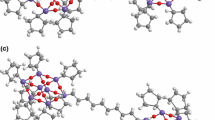Abstract
Geometrical and topological analysis of 884 crystalline structures of organosiloxanes is carried out (TOPOS software package, Cambridge structural database CSD). Fifty-eight topological types of Si n (O,C) m cluster-polymers with Si-O-Si bridging bonds were established for the first time. The largest number of crystalline structures contains 2T-chains Si2(O,C)7 (571 compounds), twinned 4T-rings Si8(O,C)20 (89 compounds), monocyclic 4T-rings Si4(O,C)12 (77 compounds), 3T-rings Si3(O,C)9 (50 compounds), and 3T-chains Si3(O,C)10 (41 compounds). Huge families of clusters-isomers with n = 6 (9 types), 8 (10 types), and10 (7 types) are allocated. Simple, unbranched L n -chains are formed at n = 3 (41 compounds), 4 (12 compounds), and 5 (2 compounds). Simple monocyclic R n -rings are formed at n = 3 (50 compounds), 4 (77 compounds), 5 (3 compounds), 6 (12 compounds) and 8 (3 compounds). Polyhedral P n -clusters are established at n = 6 (9 compounds), 8 (89 compounds), 10 (6 compounds), and 12 (6 compounds). The upper limit of the structure’s complexity of Si n (O,C) m clusters by value of polymerization degree n = 21. Polymers with high values of n = 12, 16, 18, 20, and 21 are tubular supraclusters with hierarchic structure. Supraclusters in organosiloxanes C18 H54 O15 Si12, C32 H72 O20 Si16 and C20 H70 O25 Si20 are assembled from three, four, or five equivalent 4T-chains. Supraclusters in C36 H108 O18 Si18 and C42 H126 O21 Si21 are assembled from six and seven equivalent 3T-chains. the maximum axial symmetry of these supraclusters is described by point groups C nv (n = 3–7).
Similar content being viewed by others
References
Inorganic Crystal Structure Database (ICSD), Fachin-formationszentrum Karlsruhe (FIZ), Germany, and US National Institute of Standard and Technology (NIST), United States, 2013.
Villars, P. and Cenzual, K., Pearson’s Crystal Data-Crystal Structure Database for Inorganic Compounds, Materials Park, Ohio, United States: ASM International, 2012 (on CD-ROM).
Ilyushin, G.D., Geometrical and topological model of formation, selection, and evolution of precursor nano-clusters in the convergent matrix self-assembly mechanism of crystal formation, Russ. J. Inorg. Chem., 2012, vol. 57, no. 14, pp. 1–39.
Cambridge Structural Database System (CSD), Cambridge: Cambridge Crystallographic Data Centre, 2012.
The Zeolite Framework Database. http://www.iza-structure.org/databases/.
Peskov, M.V., Blatov, V.A., Ilyushin, G.D., and Schwingenschlögl, U., Computer-aided modeling of aluminophosphate zeolites as packings of building units, J. Phys. Chem. C, 2012, vol. 116, no. 11, pp. 6734–6744.
Anurova, N.A., Blatov, V.A., Ilyushin, G.D., and Proserpio, D.M., Natural tilings for zeolite-type frame-works, J. Phys. Chem. C, 2010, vol. 114, no. 22, pp. 10160–10170.
Blatov, V.A., Ilyushin, G.D., and Proserpio, D.M., The zeolite conundrum: Why are there so many hypothetical zeolites and so few observed? A possible answer from the zeolite-type frameworks perceived as packings of tiles, Chem. Mater., 2013, vol. 25, no. 3, pp. 412–424.
Ilyushin, G.D. and Blatov, V.A., Assembly models for zeolite crystal structures according to the data of topological analysis by the tiling method, Crystallogr. Rep., 2012, vol. 57, no. 7, pp. 3–12.
Blatov, V.A. and Ilyushin, G.D., Computer modeling of self-assembly of the crystal structure of zeolite Na384[Al384Si384O1536] (H2O)422 (LTN, cF4080) from suprapolyhedral nanocluster precursors AB 2 (A-K 48, B-K 24), Crystallogr. Rep., 2012, vol. 57, no. 3, pp. 360–368.
Ilyushin, G.D., Theory of cluster self-organization of crystal-forming systems: Geometricaltopological modeling of nanocluster precursors with a hierarchical structure, Struct. Chem., 2012, vol. 23, no. 4, pp. 997–1043.
Ilyushin, G.D. and Blatov, V.A., Computer simulation of the self-assembly of the paulingite crystal structure from suprapolyhedral nanocluster precursors K6, K16, and K20, Crystallogr. Rep., 2011, vol. 56, no. 1, pp. 75–83.
Ilyushin, G.D., Blatov, V.A., and Dem’yanets, L.N., Cluster self-organization of germanate systems: Suprapolyhedral precursor nanoclusters and self-assembly of CAN-Na8(Al6Ge6O24)Ge(OH)6(H2O)2 and CAN-Cs2Na6(Al6Ge6O24)Ge(OH)6) zeolite crystal structures, Russ. J. Inorg. Chem., 2011, vol. 56, no. 10, pp. 1572–1578.
Blatov, V.A., Nanocluster analysis of intermetallic structures with the program package TOPOS, Struct. Chem., 2012, vol. 23, no. 4, pp. 955–963.
Author information
Authors and Affiliations
Corresponding author
Additional information
Original Russian Text © V.Ya. Shevchenko, V.A. Blatov, G.D. Ilyushin, 2014, published in Fizika i Khimiya Stekla.
Rights and permissions
About this article
Cite this article
Shevchenko, V.Y., Blatov, V.A. & Ilyushin, G.D. Structural chemistry of organo-siloxanes: Composition and structure of Si n (O,C) m (n = 2–21) clusters with Si-O-Si bridging bonds. Glass Phys Chem 40, 180–189 (2014). https://doi.org/10.1134/S1087659614020205
Received:
Published:
Issue Date:
DOI: https://doi.org/10.1134/S1087659614020205




